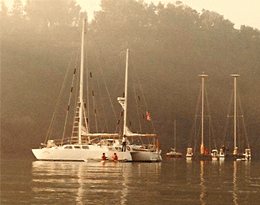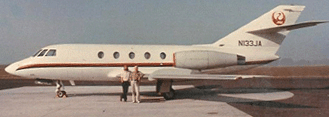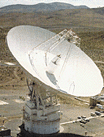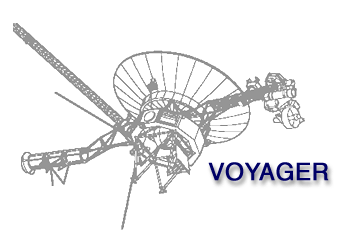|
Donald and I were living in the new two-story condominium we had bought in Fairfield, California in 1972. We had just been honorably discharged from the U.S. Air Force, during the Vietnam war. We quit our jobs. Donald, who was selling McMahon's Furniture in town, was the driving force for us "retiring" so early to live aboard our sailboat -- we were just getting into our thirties when we sold the cars and condo to cut loose and see where the winds would take us. Almitra became our only home, and she carried all our possessions. Where the winds would take us was about two thousand miles sailing and anchoring around the San Francisco Bay area, up and down the contributing rivers and connecting bays, out the Golden Gate and back, many times, and down the coast. We sailed most of the Channel Islands, spending a few nights anchoring at each one of them. When we stopped several days in Marina Del Rey to restock and visit family in Santa Monica, some friends told us of the fine natural harbors to check out on the south side of Santa Catalina Island. We did. It took us three years to leave that paradise. Almitra was the name I'd decided to want, but Donald had been resisting, for our home afloat. It did indeed become the beloved name of the two sailboats we lived aboard, in succession.
We quickly learned to love living aboard. It was quiet. It was in the midst of nature. The Moon and Sun bore us up and down a meter or two twice daily on the tides. Along with a few other live-aboard sailing families berthed nearby, it was the seagulls, ducks, loons, herons, greebs, and mud-hens who were our companions off the end of the docks. Before quitting our jobs, but after a couple of years living aboard the 36 and sailing the muddy local waters, Don found the Cross 46-foot ketch he had been looking for in one of the various marina papers' want ads. Originally named Gone With The Wind, Donald, along with Bill who had joined us living aboard, and several other friends dry-docked her in Redwood City and transformed her into the second Almitra. She had strong and graceful hulls of fiberglass over mahogany, stainless steel ports and standing rigging. She had been made in Japan in 1969, the year Don and I began our relationship. She was in need of mostly minor repairs and a re-outfitting.
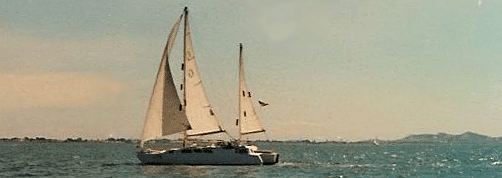
Above is our 46-ft Cross Almitra under sail in a nice marine layer breeze in the San Pablo Bay, on a southerly tack working towards the San Francisco Bay. After her launch from the Redwood City boatyard, we berthed her in the Vallejo Marina on the Napa River.
In the smaller image below and left, we've anchored off Treasure Island in the Bay, along with a few friends aboard their sailboats with whom we had arranged to meet for a few days. The mornings were especially magic, anchored there. Seagulls called through the fog and otherwise absolute stillness, until we decided to clamber out on deck for hot coffee and breakfast.
Mine was still a promising career, but Don was less reluctant to quit his job. He had been very good at sales, but his real love was sails. I accepted with some trepidation the notion that jet airplane experiences were about to lose out to sailboat experiences, without a career in sight beyond teaching celestial nav to locals. And I'd have to quit spending weekends at the Sanatana Dharma ashram, up in the Napa Valley canyons. But the mid-life retirement turned out to be incomparable. We hardly ever looked back. One of the more remarkable phases of our sailing "retirement" was the experience of living at Santa Catalina Island for a few years. We had our choice of moorings and anchorages around the island, plus the full-time use of the Banning House's "Crow's Nest." Why did we leave? I tell friends we got tired of all the sailing, snorkeling, SCUBA diving, swimming, fishing, hiking, camping, exploring, discovering, and tired of all the peace and quiet, and that we couldn't wait to get back to "reality" on the mainland. In truth, we were interested in finding better jobs than the work we had on the Island. We finally pulled ourselves away when I found a listing in the Los Angeles Times Classified ads that sounded to me like a chance to reawaken my inner space-man.
Landing an interview with Donald Kendrick of Ford Aerospace, which had just formed as an offshoot to Ford AeroNeutronics in Pasadena, I argued that I could apply my
I got the job. The task involved engineering a microprocessor-based simulation device, software and courseware, to help train the people who operate NASA's worldwide Deep Space Network, (DSN) on a new set of equipment and procedures they called the DSN Mark-IV. It was fun, and it yielded some long-term friendships. I flew on NASA-7 several times, out to the Goldstone Deep Space Communications Complex in the Mojave, to test and evaluate the training systems with end users while we worked on development. No trips to Madrid or Canberra, though. The image at left shows s 70-meter diameter antenna at Goldstone, one of many big radio telescopes in the DSN. At the time I took the job, this antenna, and its sisters in Madrid and Canberra were only ("only"!) 64 meters in diameter. They were upgraded to 70-m in preparation for Voyager-2's encounter with the seventh planet in January 1986. Don and Bill anchored Almitra off the bows of the Queen Mary in Long Beach. I took a small apartment in a house on Grand View Hill in Pasadena, and loved bicycling six miles east to work. In the mean time, Don and Bill were beginning to find work as
By the time my two-year contract was up with the Ford Aerospace team, we had finished our work and delivered the product. I had met some very cool people who worked at Caltech's Jet Propulsion Laboratory (JPL). I had learned what interplanetary spacecraft were all about, and basically how to communicate with them.
But I was out of work.
Donald supplied the income while I continued renting at Grand View and finishing my masters degree, which I had started before leaving Ford. Weekends always found me aboard Almitra in Ventura, or they found Don and Bill visiting with me at Grand View. Life was pleasant, but I needed to land another job pretty soon.
Ben hired me in 1985 just to shut me up, I'm certain. During my interview for a job at JPL as mission controller for the Galileo Jupiter orbiter which was still awaiting its first launch opportunity, Mac, the Galileo Mission Control Team Chief, told me he wanted someone with some experience flying robotic spacecraft. No matter my airplane flight experience, nor the DSN expertise I'd acquired. "Go work for Voyager for a few years and then come back," he advised me.
Music to my ears!
I wouldn't let Ben alone. He was the Voyager Mission Control Team Chief at the time, and the project was staffing up for Voyager-2's upcoming encounter with the seventh planet, Uranus. ITT Federal Electric hired me for the Voyager Mission Controller
Voyager-2 executed spectacular final encounters, with Neptune and Triton, in August 1989. Since everything was going so smoothly, I had the immense pleasure of welcoming Don and Bill for a visit that Friday night among the glass rooms of Mission Control, at the height of the final encounter activities.
The excitement continued through the weekend. Along with our little company, Space Craft International that we founded in '87, we enjoyed a fine PlanetFest celebration. Thirty thousand people flooded the Pasadena Center, and we felt like we were seeing half of them wearing SCI- designed T-shirts, or carrying away their SCI Voyager scale model kits. Carl Sagan, the widely known astronomer who was a Voyager imaging science team member, threw the flight team a party in front of JPL's Administration building that none will ever forget. His partner Ann Druyan bought a dozen fully-assembled SCI Voyagers to use as party decorations. Carl had The Planetary Society give out little bronze medals they'd gotten struck to commemorate the occasion. He even arranged for Chuck Berry to be there, dancing his guitar across the wide concrete stairway.
Don and Bill continued to work their yachting business out of Ventura. The three of us rented a roomy house up behind JPL in the "Meadows" community for seven years, and though the commute was a long one to Ventura, spending a day or three on the boat now and then made it entirely tolerable. My commute to work was a one-mile mountain-bike ride downhill. Life continued this way until Donald and Bill passed away the summer of 1993. Working as a member of the flight team for Cassini/Huygens, a mission to Saturn and Titan, followed the successful Magellan mission.
The transition is complete. Dave has been completely captivated by machines in the outer solar system, and is still making scale models of them all to share for fun, profit, and public engagement.
|

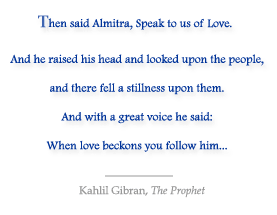
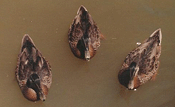 The first was a "test run" of the sailboat live-aboard concept for us; a 36-foot Piver ketch. One bright evening, walking down the dock on my way home from work, I found Don at the transom applying the name in big black uppercase letters,
The first was a "test run" of the sailboat live-aboard concept for us; a 36-foot Piver ketch. One bright evening, walking down the dock on my way home from work, I found Don at the transom applying the name in big black uppercase letters, 